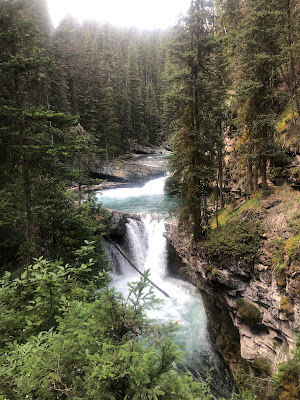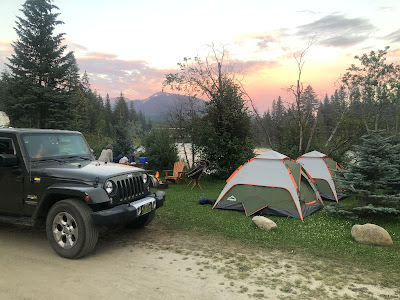2022 July 20-29
We headed west again towards Waterton National Park, with the rugged mountains on the horizon looming as we approached. Waterton Lake is one of the popular destinations in the Alberta Rockies, perhaps less visited than Banff and Lake Louise, although not much further away from Calgary; the small town at the lake is far less busy, and access is a lot easier. Initially, we took the road that leads to Red Rock Canyon, where we walked the canyon adjacent to the parking area and then to Blakiston Falls.
We then returned to the main road, stopped in the village, walked around the beach, and then had the mandatory High Tea at the Prince of Wales Hotel.
We then went to Cameron Lake and walked along the lake shore as far as we could, 500 m from the border with the USA. The path reaches a STOP sign warning that beyond this point is a “Grizzly Bear area” and advising that further progress is not permitted. Despite not reaching the end of the lake, it was an excellent walk.
We left the lake and headed to Pincher Creek, back in the “flat lands”, where we picked up necessities and spent the night. The following day took us to Head-Smashed-In Buffalo Jump, long on Alan’s list of “must go there one day” places. This UNESCO site proved to be an excellent display of local culture and history, with access to the top of the cliff over which the First Nations drove bison to their deaths.
 |
| I suspect that there was no roof when the jump was really happening |
We then headed north, stopping for a walk through Fort MacLeod, and continued to Calgary. We had decided to spend little time there this year, planning to meet up with Alan’s many friends there on a later visit, although we did dine with Marsh, catching up on his news. The Glenbow, allegedly open according to its website, proved inaccessible. We spent some time at the Farmers’ & Crafters’ Market at cSpace, the Alberta Craft Gallery, and Heritage Park, which is still a very good place to gain an appreciation of the history of Calgary since the arrival of settlers. It was good to see recognition of the "Famous 5" (although the contribution to the history of the First Nations in the region remains more limited than one would hope).
From Calgary, we made our way west towards the mountains, among more highway traffic than we had seen since Vancouver. We stopped at the riverside at Whitefish Yamnuska Recreation Area, at Tunnel Mountain Hoodoos lookout, and then at Banff Springs Hotel, where we had lunch. We then took Highway 1A, which parallels the TransCanada to Johnston Canyon, and walked to the upper falls and back, following which we headed for Two Jack Lake Main campground. We had improved our campsite set-up efficiency so much that we took less than half an hour from arrival to sitting by the campfire with beers in hand. Banff was very busy; we were able to find a parking place downhill from Banff Springs Hotel, however, the traffic was a lot busier than we had seen for a long time.
 |
| Whitefish Yamnuska Recreation Area |
 |
| Johnston Canyon |
Following the Rocky Mountains northwards (more northwest than north), we arrived at Lake Louise. On the way, we saw huge signs on the highway saying that access was limited and advising us to take shuttle buses to the lake. We were fortunate that, in fact, we found parking at the upper lot above Lake Louise, and could walk the lakeside and have lunch in the Fairview Bar at Chateau Lake Louise.
We crossed briefly into British Columbia again to visit the “Spiral Tunnels” viewpoint and Emerald Lake, where we took the Hamilton Falls walk before returning to the TransCanada Highway and heading further north to stop at the mandatory Mount Rundle viewpoint, then soaking at Banff Upper Hot Springs before returning to camp.
Before leaving this area, we visited Lake Minnewanka, then drove north past Lake Louise to the Hector Lake “viewpoint” and then to Bow Lake, where we walked to Bow Glacier Falls viewpoint through scenery somewhat reminiscent of some places in Iceland. We also stopped and took the Miskaya Canyon walk, fuelled at Saskatchewan Crossing, and then continued on the Icefields Parkway to Jasper, home for the next three days.
Bow Glacier Falls viewpoint
From our base in Jasper, we spent time at Maligne Canyon and visited Jasper Lake and the Sand Dunes.
 |
| View east from Jasper Lake Sand Dunes |
Returning northwards we stopped at Tangle Creek and its waterfall, Beauty Meadows, the Mushroom and Diadem peaks viewpoint, and stopped at the impressive Sunwapta Falls, then Goats and Glaciers, and finally Athabasca Falls before refueling in Jasper and heading west to Tête Jaune Lodge campground (where we had sought to camp earlier in our trip, unsuccessfully, since it had been full). This campground has very attractive sites on the riverbank, and it was a good spot to contemplate our further travels westward.
Our next stages of the trip:
We’ll return to British Columbia and head southwest through Southern British Columbia before heading to Vancouver Island for the last chapter of the trip this year.
Hugs
Alan & Marce





























